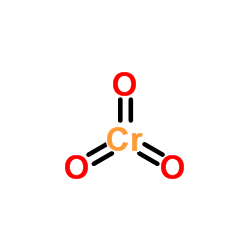chromium trioxide

chromium trioxide structure
|
Common Name | chromium trioxide | ||
|---|---|---|---|---|
| CAS Number | 1333-82-0 | Molecular Weight | 99.994 | |
| Density | 2.7 | Boiling Point | 330 °C | |
| Molecular Formula | CrO3 | Melting Point | 196 °C (dec.)(lit.) | |
| MSDS | Chinese USA | Flash Point | 250°C | |
| Symbol |





GHS03, GHS05, GHS06, GHS08, GHS09 |
Signal Word | Danger | |
|
Impairment of renal structure and function following heterogeneous chemical mixture exposure in rats.
Indian J. Exp. Biol. 52(4) , 332-43, (2014) Renal structural and functional alterations following an exposure to a heterogeneous chemical mixture (HCM) of phthalic acid di butyl ester, 1, 2-dichlorobenzene, cadmium chloride and chromium trioxide, administered through oral gavage in low doses (1/100 and... |
|
|
[Improved methodology for quantitative determination of thiabendazole].
Kokuritsu Iyakuhin Shokuhin Eisei Kenkyusho. Hokoku. (130) , 46-9, (2012) The method prescribed in the 8th edition of Japan's Specifications and Standards for Food Additives (JSSFA) for the quantitative analysis of thiabendazole was improved by eliminating the use of toxic reagents such as mercuric acetate and chromium trioxide. Fo... |
|
|
Genotoxicity of tri- and hexavalent chromium compounds in vivo and their modes of action on DNA damage in vitro.
PLoS ONE 9(8) , e103194, (2014) Chromium occurs mostly in tri- and hexavalent states in the environment. Hexavalent chromium [Cr(VI)] compounds are extensively used in diverse industries, and trivalent chromium [Cr(III)] salts are used as micronutrients and dietary supplements. In the prese... |
|
|
Carbohydrate utilization by tilapia (Oreochromis niloticus x O. aureus) as influenced by different chromium sources.
J. Nutr. 123(10) , 1747-53, (1993) An experiment was conducted to study the influence of three different forms of chromium (CrCl3.6H2O, Na2CrO4.4H2O and Cr2O3) on the utilization of two carbohydrates (glucose and cornstarch) by juvenile hybrid tilapia (Oreochromis niloticus x O. aureus). Avera... |
|
|
Arsenite and cadmium, but not chromium, induce NAD(P)H:quinone oxidoreductase 1 through transcriptional mechanisms, in spite of post-transcriptional modifications.
Toxicol. In Vitro 22(5) , 1184-90, (2008) NAD(P)H:quinone oxidoreductase (Nqo1)-mediated detoxification of quinones plays a critical role in cancer prevention. Metals alter the carcinogenicity of AhR ligands, such as TCDD, by modulating the induction of Nqo1, but the mechanism(s) remain unresolved. T... |
|
|
Structure of an exocellular polysaccharide produced by Streptococcus thermophilus.
Carbohydr. Res. 198(2) , 313-21, (1990) Streptococcus thermophilus strains grown on skimmed milk produced a viscosifying, exocellular, and water-soluble polysaccharide which contains D-glucose, D-galactose, and N-acetyl-D-galactosamine in the ratio of 1:2:1. Methylation analysis identified the glyc... |
|
|
Chemical structure of the carbohydrate backbone of Vibrio parahaemolyticus serotype 012 lipopolysaccharide.
Eur. J. Biochem. 200(3) , 689-98, (1991) The chemical structure of the saccharide portion of Vibrio parahaemolyticus serotype 012 lipopolysaccharide was studied. Using chemical degradation and modification, as well as methylation analysis in combination with GLC-MS, laser-desorption mass spectrometr... |
|
|
Evidence for the protective effect of ascorbic acid (vitamin C) in treatment with gamma-rays and chromium (VI) oxide (CrO3) in somatic cells of Drosophila.
Mutat. Res. 346(1) , 19-21, (1995)
|
|
|
Removal of copper, chromium and arsenic from preservative-treated wood by chemical extraction-fungal bioleaching.
Waste Manag. 29(6) , 1885-91, (2009) Large volumes of preservative-treated wood containing toxic Cr, Cu and As salts are decommissioned worldwide. This study investigated the effectiveness of solid-state fermentation with copper-tolerant brown-rot fungi for the remediation of wood treated with c... |
|
|
Synthesis of C14,15-dihydro-C22,25-epi north unit of cephalostatin 1 via "red-ox" modifications of hecogenin acetate.
Org. Lett. 11(1) , 5-8, (2009) The C14,15-dihydro-C22,25-epi north unit of cephalostatin 1 has been synthesized in 11 operations from commercially available hecogenin acetate via multiple reductions and oxidations. The key transformations include (i) Cr(VI)-catalyzed E-ring opening, (ii) C... |